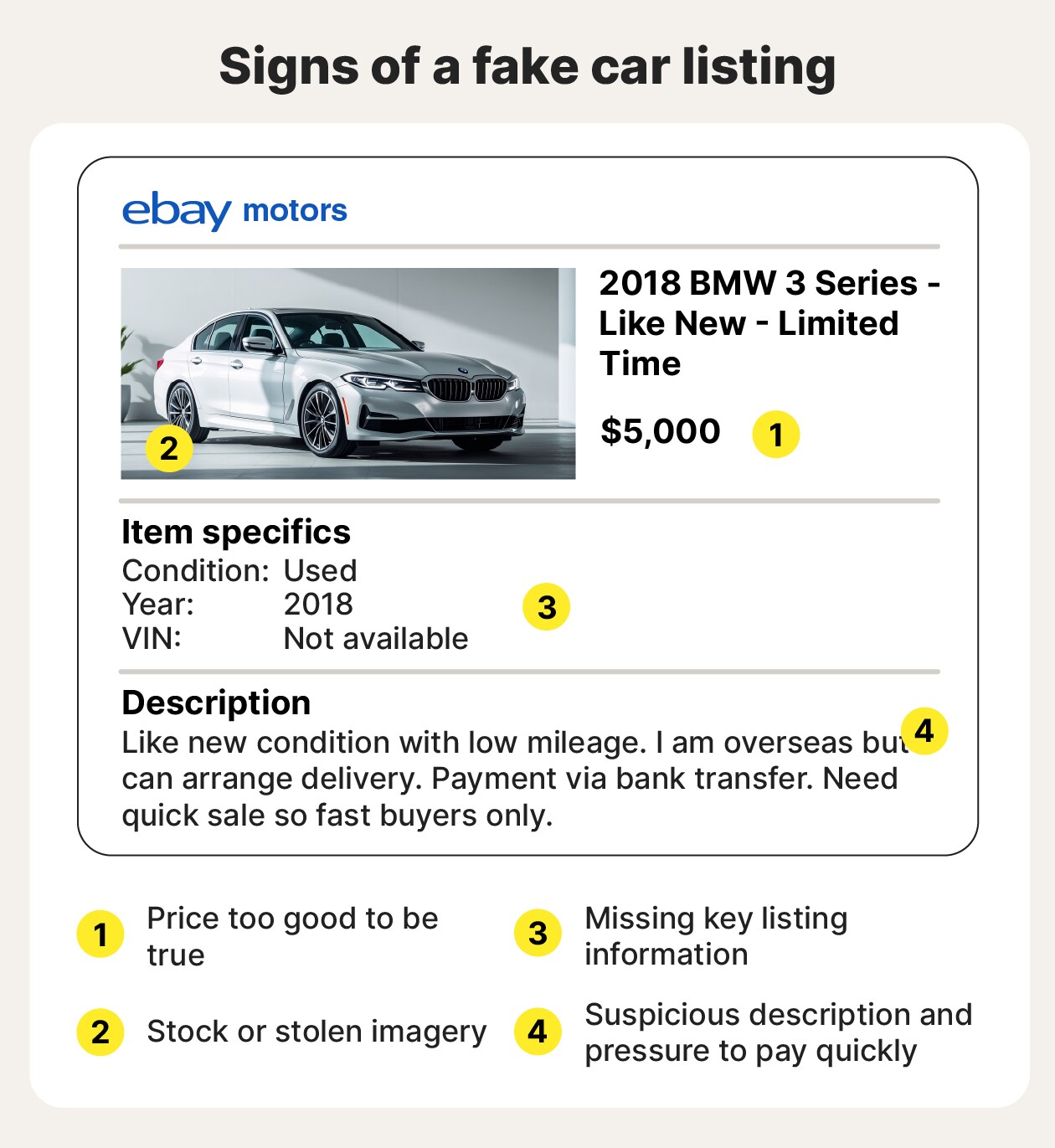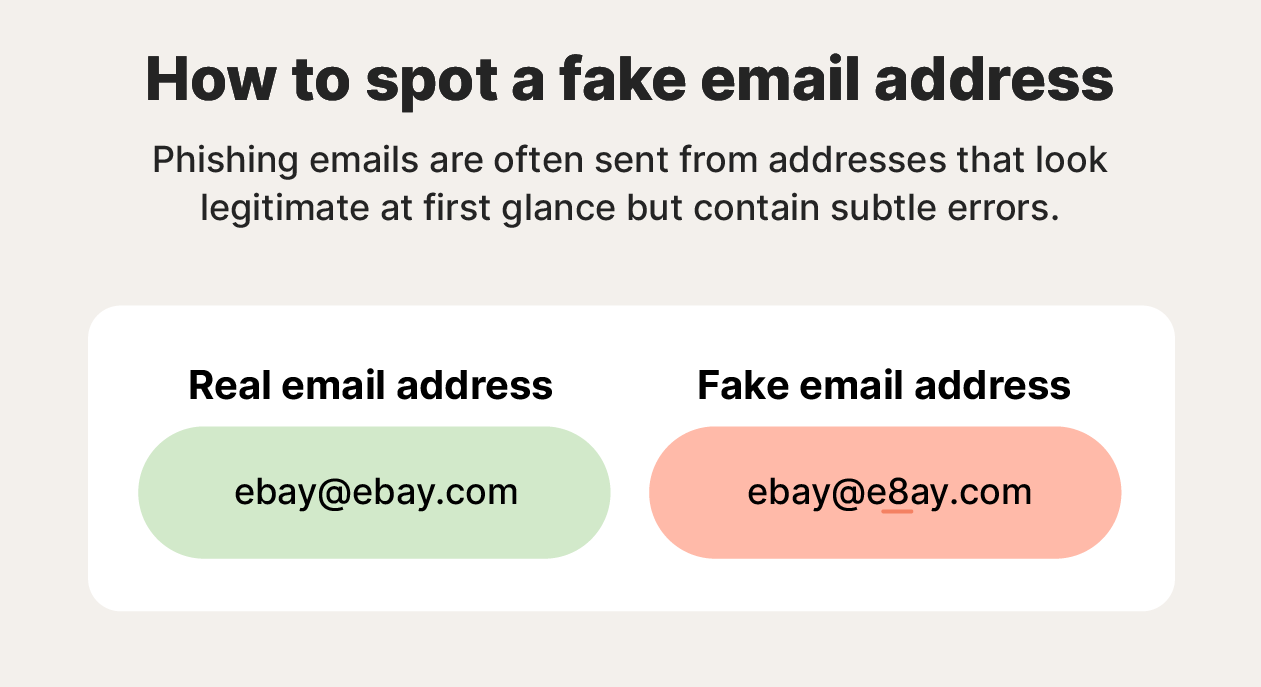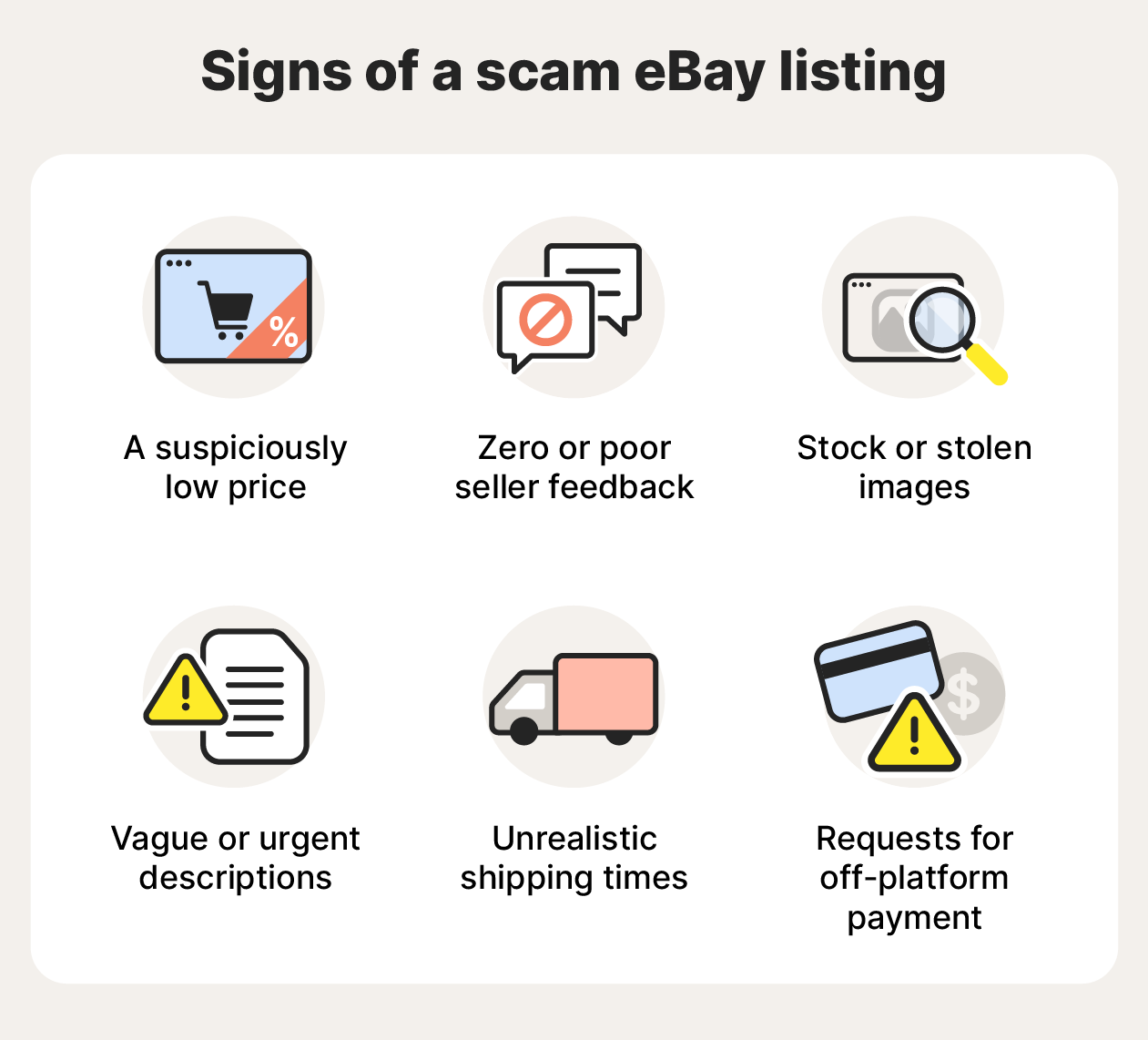Have you already been scammed on eBay? Click here to learn how to file a report to try and get your money back, whether you’re a buyer or seller.
eBay is a hugely popular website for online shopping, with over 100 million active users browsing more than 2 billion live listings as of 2025. And with that large user base comes plenty of opportunities for predatory scammers.
While eBay itself is completely legitimate and generally safe to use, knowing how scammers take advantage of the platform can help you spot and dodge scams when you encounter them.
How do eBay scams work?
eBay scams work in much the same way as internet scams on any other online shopping website. Common approaches scammers use include creating misleading listings, requesting to communicate off-platform, and applying pressure tactics to get you to act without thinking.
Keep your guard up and look out for the following common scam tactics as you shop on eBay:
- Misleading listings: An eBay listing that features a ridiculously low price, uses stock photos, or includes vague descriptions can mislead you into buying a fake or nonexistent product.
- Email attachments or links: Attachments or links in suspicious emails claiming to be from eBay may be framed as invoices or tracking details, but they may be infected with malware or lead to a fake website.
- Off-platform requests: A seller asking to communicate or finalize the transaction off eBay is a huge red flag that they’re trying to trick you. There’s no reason you can’t talk and transact exclusively on eBay.
- Pushy language: Language designed to create a sense of urgency (like “buy now!”) or ultimatums (“If you don’t buy in the next 10 minutes, I’ll find another buyer”) is often used to pressure you into acting without thinking — a hallmark of scams.
10 common types of eBay scams
While there are countless ways scammers can try to trick you on eBay, the most common scam types are similar to schemes you might encounter on any other online marketplace. Here’s a breakdown of 10 of the most common eBay scams, including shipping scams, gift card scams, escrow scams, and more.
1. Scam listings on eBay Motors
eBay Motors is eBay’s dedicated vehicle marketplace. Scammers on this platform often create fake vehicle or vehicle part listings with attractive low prices, but request that interested parties pay off eBay.
Vehicle scams are common largely because of the potential reward for the scammer. Even with the low price tags they use on fake listings, scammers are guaranteed a good return if they succeed in tricking someone into buying.
Signs of an eBay Motors scam include:
- Stock photos or stolen photos that you can find elsewhere on the internet with a reverse image search.
- Listings that include sob stories or emotional appeals designed to elicit sympathy and encourage you to buy.
- The seller insists on handling everything online, without an in-person meeting that would allow you to inspect the vehicle.
- The seller refuses to provide a Vehicle Identification Number (VIN) or a vehicle history report.


2. eBay gift card scams
Gift card scams are common across lots of online platforms, from eBay to Facebook Marketplace. They involve the scammer attempting to trick victims into paying with gift cards.
Scammers on eBay or another platform may encourage you to make a purchase with eBay gift cards. They’ll ask you to send the codes in a message or email but will then redeem the value immediately and disappear, leaving you without the product you paid for.
To persuade you, they may claim that gift cards are a “secure” or “eBay-approved” payment method. They might even offer you a discount if you pay with gift cards. In reality, though, they’re trying to bypass eBay’s Money Back Guarantee policy, leaving you with no recourse options.
3. eBay local pickup scams
A local pickup scam on eBay involves a scammer posing as a buyer and using the “local pickup” delivery option to avoid eBay’s shipping and payment protections.
They might then send a fake payment confirmation to trick the seller into handing over the item. Alternatively, after picking the item up, they might claim that they never picked up the item and seek a fraudulent refund.
Warning signs of a local pickup scam include:
- A buyer insisting on picking an item up immediately and refusing other delivery options.
- A suspicious email claiming that a payment is "on hold" or will be released after pickup.
- A buyer refusing to use electronic payment methods, instead insisting on paying in cash.
4. eBay third-party payment scams
Third-party payment scams on eBay occur when scam sellers ask buyers to make payments off the platform, instead of using eBay’s own secure checkout. They’ll often claim this is safer or faster, but you won’t be covered by eBay’s buyer protection policy.
Paying off-platform exposes you to the risk that the seller won’t deliver the item you’ve bought, or deliver something that doesn’t match the listing description, and you’ll be left out of pocket.
Tip: Avoid paying for items on eBay via wire transfer or with a third-party payment app like Venmo, Cash App, or Zelle. Instead, pay on-platform using eBay’s secure checkout system to ensure your purchase is protected.
5. eBay email scams
eBay email scams are phishing attacks where scammers send fake emails impersonating eBay to steal your personal or financial information. These emails may claim there's a problem with your account, a payment issue, or you’ve won a prize.
However, if you click a link or open an attachment included in the email, you may unknowingly give away your personal information, pay the scammer, or infect your device with malware.
Common themes of eBay email scams include:
- Customer support: The scammer pretends to be an eBay customer support representative, offering to help you with a “problem” on your account if you provide your password or two-factor authentication code.
- Payment problem: An email claims there’s a problem with an eBay payment you’ve made, and instructs you to click a link to resolve it. But clicking it triggers a malware infection or leads you to a fake webpage asking for your banking details.
- Prize or giveaway: An email claiming to be from eBay congratulates you on winning a prize, like a free item or eBay gift card, and asks you to click a link or provide sensitive personal information to redeem it.
All the traditional warning signs of phishing emails also apply to eBay email scams. That includes generic greetings, suspicious email addresses that contain misspellings or extra characters, strange links that you’re encouraged to click, and requests for sensitive information like your login details or bank account number.


If you’re unsure whether an email from eBay is fake, check your inbox on the eBay website or app to see if it appears there, or contact eBay customer support directly to verify it. Don’t reply, click links, or open attachments until you’re sure it’s real.
You can forward suspicious emails you suspect are phishing attempts to spoof@ebay.com to help the eBay team detect trends and fight scammers.
6. eBay shipping scams
As you’d expect from an online marketplace, many eBay scams revolve around shipping. From non-delivery of a product you’ve bought to surprise packages landing on your doorstep, these are some of the most common eBay shipping scams:
- Non-delivery scam: Some scam sellers, particularly those who encouraged you to pay with a third-party payment method, will take your payment but never ship the item you bought.
- Wrong address scam: If an item you’ve bought is shipped to a different address, like one they have access to, it will be marked as “delivered” even if you don’t receive it, making it harder for you to claim a refund.
- Broken item scam: While items can be damaged during the shipping process, some scammers might intentionally send you broken products and refuse to offer a refund, instead blaming you or the shipping firm.
- Empty box scam: Some scammers may ship you an empty box. When you file a complaint, the seller might claim the item was shipped properly, forcing you to provide evidence it wasn’t.
- Brushing scam: Brushing scams involve sellers sending items you didn’t order to your address. They do this so they can write a glowing review in your name. While this scam might seem innocuous, it’s a sign that your personal information may be exposed.
7. eBay return scams
Also known as refund scams, eBay return scams involve buyers attempting to fraudulently request a refund for an item that doesn’t qualify for one. To support their scammy claim, they might lie and say they never received what they bought or that the item arrived broken. These scams are tricky to spot ahead of time, because the transaction will seem normal until after the buyer receives the item.
Key warning signs that you’re dealing with an eBay return scammer include:
- A return or refund request that’s filed immediately after you confirm you’ve shipped the item.
- Returned packages containing a different item than what you shipped, or an item that’s not in the same condition you sent it in.
8. eBay counterfeit item scams
eBay counterfeit item scams involve sellers listing fake or knockoff products as genuine, often high-demand items like designer goods, electronics, or collectibles. These items are typically offered at bargain prices, and the listings may include stock or stolen images.
In reality, the product on offer isn’t legitimate, which you won’t notice until it arrives. By that point, the seller might have disappeared, leaving you to fight for a refund which might not be possible.
Look out for the following red flags that an eBay item you’re interested in could be counterfeit:
- A typically-expensive brand-name product being sold at a ridiculously low price.
- No proof of authenticity, like a certificate or original purchase receipt.
- Photos that appear to have been sourced from a stock image library, stolen from another website, or AI-generated.
- Sellers with only a little amount of feedback, or consistently low ratings.
To help keep yourself safe, only buy from top-rated sellers, make sure to read seller reviews, and avoid deals that seem too good to be true.
9. eBay escrow scam
eBay escrow scams involve scammers pretending to use a secure escrow service to handle payments for high-value items like cars or electronics. A scam seller running an escrow scam will claim your funds will be held safely until you receive the item, but direct you to a fake escrow website. It might look legitimate, but it’s actually controlled by the scammer.
Once you deposit money into the website under the illusion it’s secure, the scammer will disappear and you’ll never receive the item you ordered. The payment information you used to deposit the money may also be at risk of being misused in further fraud or identity theft.
10. eBay chargeback scam
eBay chargeback scams happen when a buyer makes a purchase, receives the product, then files a chargeback request with their bank or credit card issuer. They might falsely claim they never received the product they ordered, or that the charge was unauthorized.
Buyers who insist on using a third-party payment method, like wire transfers, may be more likely to attempt a chargeback. And, if you agreed to accept an off-platform payment, resolving the scam could be difficult, even if you have proof of delivery.
To help minimize the risk of being victimized by a chargeback scam, only accept payments through eBay’s checkout system, always use tracked shipping methods, and keep clear records you can refer back to if needed.
How to not get scammed on eBay
Scams targeting both buyers and sellers may be lurking on eBay, but whatever side of the transaction you’re on, there are some effective strategies you can use to help protect yourself.
Tips to avoid scams as a buyer
Whether you’re on eBay or another online marketplace, shopping more safely online requires that you build a baseline understanding of what a scam looks like, and know what to avoid. Here are some top tips to help stop you falling victim to scam sellers on eBay:
- Learn how to identify suspicious listings: Listings with vague descriptions, no specific product details like dimensions, urgent language such as “buy now,” no-return policies, and stock images are immediate red flags.
- Investigate unrealistic deals: If you find a listing with a price that seems too good to be true, compare it with other listings on eBay or elsewhere on the internet. Brand names are rarely steeply discounted, and if only one listing reflects a discounted price, it may be a counterfeit product or scam.
- Check seller feedback: Avoid sellers with low ratings, recent complaints, or a short selling history. eBay’s feedback system is there to help you assess whether a seller is likely to provide a good experience, and negative feedback should be an immediate red flag.
- Don’t communicate off-platform: Moving a chat with a seller off eBay can leave you more vulnerable to scams like WhatsApp scams or Telegram scams. It will also make it difficult to prove your case to eBay in the event you get scammed.
- Don’t make off-platform payments: Keeping your transactions on eBay means you benefit from payment protection if the item you buy is damaged or turns out to be a scam. You can use several payment methods on eBay, including credit and debit cards, Apple Pay, Google Pay, and PayPal. Just don’t fall for sellers who ask you to send gift card codes, make wire transfers, or pay directly through apps like Venmo or Zelle.
- Avoid suspicious links and attachments: Links and attachments included in emails claiming to be from eBay may be a phishing attack. These could lead you to an unsafe website or infect your device with malware, allowing hackers to steal your data.
- Save all communication and transaction records: Having evidence to support your case will help you get a refund if you ever need to open a dispute.


Tips to avoid scams as a seller
Selling on eBay, or any other online platform, comes with risks. Understanding what red flags indicate a scam buyer can help you avoid losing money. Here are some key strategies you can use to stay safer while you sell:
- Check buyer feedback: eBay’s feedback system isn’t just to rate sellers. You can also check interested buyers’ ratings to verify whether they seem like legitimate users. Look out for profiles with only a few reviews or negative reviews.
- Only accept payment through eBay: Keeping transactions on eBay makes them easier to track, reducing the challenge if you get a scam buyer who tries to pull a scam on you.
- Photograph items and packaging before shipping: Documenting the condition and contents of any parcels you send to buyers can help protect you against fraudulent damaged or missing item claims.
- Require a delivery confirmation signature: A delivery confirmation signature requires the buyer to be physically present and sign off on receipt of an item. This provides evidence that the item was received, in case there’s a dispute later on.
- Set clear return policies: To help prevent return and chargeback scams, require buyers to return items before you consider issuing a refund.
How to get money back from an eBay scammer
Getting your money back from an eBay scammer is generally only possible if the transaction took place entirely on-platform. This means it’s covered by eBay’s buyer and seller protection policies. If you’ve been scammed as a buyer or seller on eBay, follow these steps to try and get your money back.
As a buyer
As a buyer, you’re covered by eBay’s Money Back Guarantee, provided your purchase meets the criteria. This criteria includes paying for the item on eBay with an eligible payment method, the item not falling into an excluded category, and you reporting the issue within 30 days of delivery.
Here’s a step-by-step guide to reporting a scam seller and getting your money back:
- Check the order details: Log in to your eBay account and confirm the item status, tracking info, and estimated delivery date.
- Contact the seller directly: Message the seller through eBay to request a refund or otherwise resolve the issue.
- Ask eBay to step in and help: If your item didn't arrive or you want to return the item, and the seller doesn’t respond, go to the item in your purchase history and click “See request details/see return details” > “Ask eBay to step in and help.” Choose a reason from the dropdown menu and click “Confirm.”
- Provide evidence: If applicable to your case, upload any photos, messages, or tracking details that support your claim.
- Wait for eBay’s resolution: eBay usually resolves cases within 3-5 business days and will refund you if you're eligible under the conditions outlined by the Money Back Guarantee.
- Report the seller: If you believe the seller violates eBay’s policies, you can report them, selecting the reason and providing more details when prompted.
- Check your payment method: If eBay denies the refund, you can try to get your money back by contacting the payment provider, whether that’s your bank, credit card issuer, or PayPal. While not all banks refund scammed money, you may be able to explore options to file a chargeback or dispute.
- Warn others away from the seller: Leave feedback on the seller’s profile describing the problem and how it was handled, to warn others that they could be a scammer.
As a seller
eBay offers a range of seller protections designed to protect you against abuse or scams. While they may not cover you in all cases, follow these steps to explore your recourse options after being scammed as a seller:
- Collect evidence: Save any messages, photos, tracking info, or other proof that you’ve been scammed to support your claim.
- Ensure you’re eligible for seller protection: If the transaction you were scammed on meets eBay’s seller protection criteria and you followed through on your service promises, such as honoring your return policy, you should qualify for payment dispute seller protection.
- Report the issue to eBay: Go to the Seller Hub, select “Report a Buyer,” and upload any relevant photos, documents, or information when prompted. eBay will review your case and contact you if more detail is needed. A resolution will typically be provided within 3-5 business days.
- Appeal the decision: If eBay sides with the buyer unfairly, use the option to appeal the case, using your supporting evidence to demonstrate why you believe the decision was wrong.
Help protect your information and identity online
While many eBay scammers are looking for quick and easy ways to steal money or get products for free, others may be in the market for sensitive personal or financial information they can use to steal your identity.
Join LifeLock Standard to get protection if a scam spirals into full-blown identity theft. It’s the best identity protection for your dollar — it comes with features such as social security alerts, credit monitoring, dark web monitoring, and restoration support should you fall victim to identity theft.
FAQs
Can you get scammed on eBay?
Yes, you can get scammed on eBay. However, learning how common eBay scams work and taking the right precautions can reduce the risk. Key steps include only using eBay's messaging and payment systems, checking buyer or seller feedback, and ignoring listings or communications that seem suspicious.
Is eBay safe to buy from?
eBay is generally safe to buy from, especially when purchasing from top-rated sellers and using eBay-approved payment methods. The platform also offers buyer protection for most transactions under eBay’s Money Back Guarantee.
Does eBay refund scams?
Yes, eBay typically refunds buyers who are scammed through its Money Back Guarantee program. If an item you purchased doesn't arrive, is significantly different from the description, or is counterfeit, you can file a claim. Make sure you buy items that are eligible, and that you follow eBay’s rules and use its official payment methods to qualify.
How can you tell if someone is an eBay scammer?
Key signs that someone is an eBay scammer include poor or no feedback, vague product descriptions, too-good-to-be-true prices, and requests for you to communicate or pay off-platform. Always check the seller’s profile before making a purchase and trust your instincts if something feels wrong.
Are eBay bids a scam?
eBay bids are not inherently a scam, but some sellers employ a strategy known as shill bidding — where fake accounts are used to place bids and inflate the price of an item. While eBay monitors for this behavior, shill bidding can occur. Stick to reputable sellers, set a maximum bid you're comfortable with, or consider using Buy It Now if you want to avoid bidding altogether.
eBay is operated by eBay Inc.
Editor’s note: Our articles provide educational information. LifeLock offerings may not cover or protect against every type of crime, fraud, or threat we write about.
Start your protection,
enroll in minutes.
LifeLock is part of Gen – a global company with a family of trusted brands.
Copyright © 2025 Gen Digital Inc. All rights reserved. Gen trademarks or registered trademarks are property of Gen Digital Inc. or its affiliates. Firefox is a trademark of Mozilla Foundation. Android, Google Chrome, Google Play and the Google Play logo are trademarks of Google, LLC. Mac, iPhone, iPad, Apple and the Apple logo are trademarks of Apple Inc., registered in the U.S. and other countries. App Store is a service mark of Apple Inc. Alexa and all related logos are trademarks of Amazon.com, Inc. or its affiliates. Microsoft and the Window logo are trademarks of Microsoft Corporation in the U.S. and other countries. The Android robot is reproduced or modified from work created and shared by Google and used according to terms described in the Creative Commons 3.0 Attribution License. Other names may be trademarks of their respective owners.







